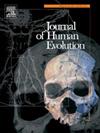Human midfacial growth pattern differs from that of Neanderthals and chimpanzees
IF 3.1
1区 地球科学
Q1 ANTHROPOLOGY
引用次数: 0
Abstract
Present-day humans have small and retracted midfaces, while Neanderthals possess large and forwardly projected midfaces. To understand the ontogenetic patterns underlying these characteristic morphologies, we compared maxillary growth and development from birth to adulthood in present-day humans (Homo sapiens; n = 128), Neanderthals (Homo neanderthalensis; n = 13), and chimpanzees (Pan troglodytes verus; n = 33) using macroscopic (i.e., geometric morphometrics) and microscopic (i.e., surface histology) approaches. Using geometric morphometrics to quantify macroscopic patterns of growth and development, we found that the midfaces of present-day humans are on average already smaller at birth than those of Neanderthals and grow more slowly after birth. In particular, we find an early cessation of growth around adolescence, which is unique to our species. Microscopically, this is reflected in reduced amounts of bone resorption, indicative of decreased cellular activities linked to bone development. Greater amounts of bone formation in the infraorbital and nasal regions and faster growth rates are responsible for the large Neanderthal midface. These results highlight the importance of postnatal ontogeny (especially in late stages) for explaining facial differences between Neanderthals and present-day humans, as well as part of the gracilization process characteristic of present-day humans.
人类面部中部的生长模式不同于尼安德特人和黑猩猩
现代人类的中脸小而向后缩,而尼安德特人的中脸大而向前突出。为了了解这些特征形态背后的个体发生模式,我们比较了现代人类(智人;n = 128),尼安德特人(Homo neanderthalensis;n = 13),黑猩猩(Pan troglodytes verus;N = 33),采用宏观(即几何形态计量学)和微观(即表面组织学)方法。使用几何形态计量学来量化生长和发育的宏观模式,我们发现现代人的中脸在出生时平均已经比尼安德特人小,出生后增长更慢。特别是,我们发现青春期前后生长会提前停止,这是人类独有的。显微镜下,这反映在骨吸收量减少,表明与骨发育有关的细胞活动减少。在眶下和鼻区有大量的骨骼形成,生长速度更快,这是尼安德特人中脸较大的原因。这些结果强调了出生后个体发育(特别是在后期)对于解释尼安德特人和现代人之间面部差异的重要性,以及现代人特征的部分纤体化过程。
本文章由计算机程序翻译,如有差异,请以英文原文为准。
求助全文
约1分钟内获得全文
求助全文
来源期刊

Journal of Human Evolution
生物-进化生物学
CiteScore
6.30
自引率
15.60%
发文量
104
审稿时长
3 months
期刊介绍:
The Journal of Human Evolution concentrates on publishing the highest quality papers covering all aspects of human evolution. The central focus is aimed jointly at paleoanthropological work, covering human and primate fossils, and at comparative studies of living species, including both morphological and molecular evidence. These include descriptions of new discoveries, interpretative analyses of new and previously described material, and assessments of the phylogeny and paleobiology of primate species. Submissions should address issues and questions of broad interest in paleoanthropology.
 求助内容:
求助内容: 应助结果提醒方式:
应助结果提醒方式:


